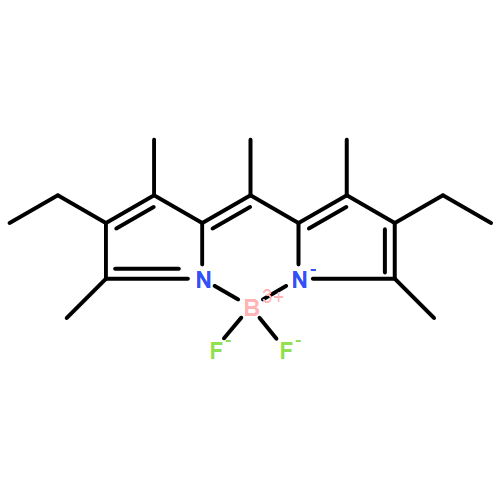Co-reporter: Eduardo Palao, Santiago de la Moya, Antonia R. Agarrabeitia, Ixone Esnal, Jorge Bañuelos, Íñigo López-Arbeloa, and María J. Ortiz
pp: 4364-4367
Publication Date(Web):August 25, 2014
DOI: 10.1021/ol501945v
Selected meso BODIPYs (chemically reactive, difficult to obtain by established procedures, or photophysically or electrochemically attractive) have been obtained by unprecedented selective lateral lithiation of 8-methylBODIPYs. The physical study of the obtained new meso BODIPYs reveals interesting tunable properties related to the activation of intramolecular charge-transfer processes, endorsing the new synthetic methodology as useful for the development of smarter BODIPY dyes for technological applications.
Co-reporter: I. Esnal, G. Duran-Sampedro, A. R. Agarrabeitia, J. Bañuelos, I. García-Moreno, M. A. Macías, E. Peña-Cabrera, I. López-Arbeloa, S. de la Moya and M. J. Ortiz
pp: 8239-8247
Publication Date(Web):23 Feb 2015
DOI: 10.1039/C5CP00193E
Linking amino and hydroxycoumarins to BODIPYs through the amino or hydroxyl group lets the easy construction of unprecedented photostable coumarin–BODIPY hybrids with broadened and enhanced absorption in the UV spectral region, and outstanding wavelength-tunable laser action within the green-to-red spectral region (∼520–680 nm). These laser dyes allow the generation of a valuable tunable UV (∼260–350 nm) laser source by frequency doubling, which is essential to study accurately the photochemistry of biological molecules under solar irradiation. The tunability is achieved by selecting the substitution pattern of the hybrid. Key factors are the linking heteroatom (nitrogen vs. oxygen), the number of coumarin units joined to the BODIPY framework and the involved linking positions.
Co-reporter: I. Esnal, G. Duran-Sampedro, A. R. Agarrabeitia, J. Bañuelos, I. García-Moreno, M. A. Macías, E. Peña-Cabrera, I. López-Arbeloa, S. de la Moya and M. J. Ortiz
pp: NaN8247-8247
Publication Date(Web):2015/02/23
DOI: 10.1039/C5CP00193E
Linking amino and hydroxycoumarins to BODIPYs through the amino or hydroxyl group lets the easy construction of unprecedented photostable coumarin–BODIPY hybrids with broadened and enhanced absorption in the UV spectral region, and outstanding wavelength-tunable laser action within the green-to-red spectral region (∼520–680 nm). These laser dyes allow the generation of a valuable tunable UV (∼260–350 nm) laser source by frequency doubling, which is essential to study accurately the photochemistry of biological molecules under solar irradiation. The tunability is achieved by selecting the substitution pattern of the hybrid. Key factors are the linking heteroatom (nitrogen vs. oxygen), the number of coumarin units joined to the BODIPY framework and the involved linking positions.


